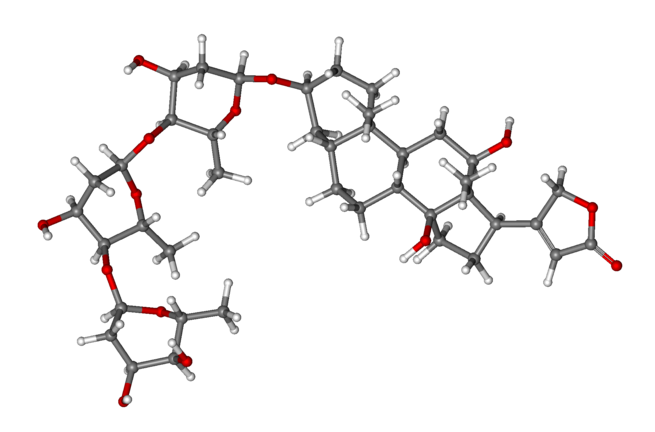Main Difference
The main difference between Digoxin and Digitalis is that the Digoxin is a chemical compound and Digitalis is a genus of plants.
-
Digoxin
Digoxin, sold under the brand name Lanoxin among others, is a medication used to treat various heart conditions. Most frequently it is used for atrial fibrillation, atrial flutter, and heart failure. Digoxin is taken by mouth or by injection into a vein.Common side effects include breast enlargement with other side effects generally due to an excessive dose. These side effects may include loss of appetite, nausea, trouble seeing, confusion, and an irregular heartbeat. Greater care is required in older people and those with poor kidney function. It is unclear whether use during pregnancy is safe. Digoxin is in the cardiac glycoside family of medications.Digoxin was first isolated in 1930 from the foxglove plant, Digitalis lanata. It is on the World Health Organization’s List of Essential Medicines, the most effective and safe medicines needed in a health system. The wholesale cost in the developing world is about US$0.21–6.60 a month. In the United States it generally costs less than $25 per month, as of 2015. In 2016 it was the 145th most prescribed medication in the United States with more than 4 million prescriptions.
-
Digitalis
Digitalis ( or ) is a genus of about 20 species of herbaceous perennials, shrubs, and biennials commonly called foxgloves.
This genus was traditionally placed in the figwort family Scrophulariaceae, but recent phylogenetic research has placed it in the much enlarged family Plantaginaceae. This genus is native to western and southwestern Europe, western and central Asia and northwestern Africa. The scientific name means “finger-like” and refers to the ease with which a flower of Digitalis purpurea can be fitted over a human fingertip. The flowers are produced on a tall spike, are tubular, and vary in colour with species, from purple to pink, white, and yellow. The best-known species is the common foxglove, Digitalis purpurea. This biennial plant is often grown as an ornamental plant due to its vivid flowers which range in colour from various purple tints through pink, light grey, and purely white. The flowers can also possess various marks and spottings. The first year of growth produces only the stem with its long, basal leaves. During the second year of the plant’s life, a long, leafy stem from 50 to 255 centimetres tall grows atop the roots of healthy plants.
Other garden-worthy species include D. ferruginea, D. grandiflora, D. lutea and D. parviflora.Larvae of the foxglove pug, a moth, consume the flowers of the common foxglove for food. Other species of Lepidoptera eat the leaves, including the lesser yellow underwing.
The term digitalis is also used for drug preparations that contain cardiac glycosides, particularly one called digoxin, extracted from various plants of this genus.
-
Digoxin (noun)
A purified cardiac glycoside extracted from the foxglove plant, Digitalis lanata, widely used in the treatment of heart conditions such as atrial fibrillation.
-
Digitalis (noun)
Any plant of the genus Digitalis (herbaceous plants of the Plantaginaceae family, including the foxglove, Digitalis purpurea).
-
Digitalis (noun)
A medical extract of Digitalis purpurea prescribed for heart failure etc.
-
Digoxin (noun)
a poisonous compound present in the foxglove and other plants. It is a steroid glycoside and is used in small doses as a cardiac stimulant.

